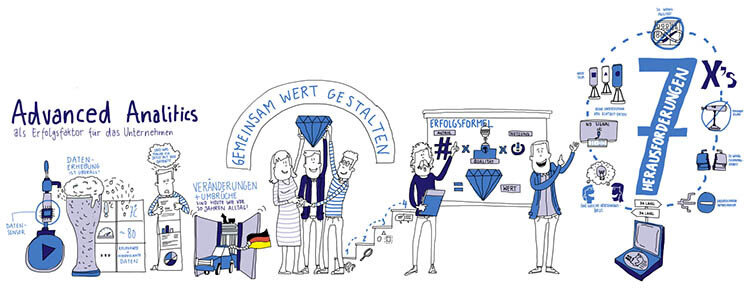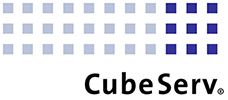Making business analytics easier ✅ and more effective ✅ is challenging. With this blog(series), I present my solution approaches for discussion. ✌
It is said that people only use 10% of their brains. Do you have the feeling it’s the same with your business analytics? Does the 10% myth get to the heart of the matter?
Business analytics is essential for a company’s success. That would have been a great motto for our CSC2020. But this year everything is different at CubeServ: Due to the Covid-19 crisis, we had to cancel our CubeServ Congress. In previous years, we have used this as an opportunity for a lively exchange between customers. It is precisely the exchange of different perspectives in discussions and thus receiving suggestions for solutions and approaches that makes this congress so valuable for me.
Nevertheless, our customers are facing major challenges – and analytics can help with these. The potential of existing in-house solutions is often not sufficiently recognized. New terms buzz around the room and lead to duplication instead of bringing together the various solution approaches.
The same questions keep cropping up in recent discussions with customers:
- How is SAP positioning itself in these challenging times?
- What solutions does SAP offer? And where is the direct added value for users?
- What experiences have we had with the use of non-SAP tools in combination with SAP tools?

SAP Analytics is geared to the needs of business users
With its modern tools, SAP Analytics provides a good basis for establishing a business analytics platform. SAP Analytics Cloud offers business users a whole host of possibilities. My colleagues show impressive examples here as well. Technology is an important building block for a good solution. It is just as important to me to establish the analytics process.
In my projects, a good project method has helped me to establish such a process. The knowledge from thousands of projects has flowed into the project management “Body of Knowledge” as well as the architecture management framework “TOGAF“. Both methods have helped me to successfully implement projects. They provide a good framework that guarantees good results with a sense of proportion and common sense.
Some SAP departments focus very strongly on the operation of existing BI applications. In my opinion, there is great potential in the use of supplementary tools (e.g. Power BI, Tableau, R-Studio, Jupyter Notebook, Google Analytics) for the best possible realization of new requirements with heterogeneous data sources. I think it is wrong to leave this potential only to new specialists.
SAP provides the right vision with its analytical products. Many good approaches can already be seen today. Many users despair because the products are not (yet) available for a wide range of applications. I can’t create a perfect SAP world for my customers. However, my customers do manage to create suitable BI applications with the help of our consulting services.
Modern solutions are becoming even stronger:
- build on SAP HANA,
- utilize the “low-hanging fruits” of applications such as S/4HANA,
- establish the SAP Data Warehouse Cloud for the business data model and
- push the SAP Analytics Cloud reporting platform.
These new applications can only be successfully established if the added value is directly felt by each individual user. Users rightly perceive that their recommendations are being heard and incorporated into these solutions. Their own tool requests are not perceived as threatening but are integrated into the platform.
For me, digital sales is an example of the successful transformation and digitalization of an important business process. Personal contact remains the basis for a close and trusting relationship between customer and consultant. New topics and innovative solutions can be easily disseminated digitally. Perhaps you have already become aware of our “People Plan” solution? With this solution and the accompanying marketing, we have managed to master the balancing act between the desire to show everyone the added value and pointless harassment.
What is next?
With the following blogs, I would like to encourage discussion. A website or blog cannot replace face-to-face conversation. Feedback from your point of view is very welcome!
The following posts are planned:
- Business Analytics vs. Business Intelligence
- What is SAP Analytics? The SAP Data Warehouse Portfolio
- SAP Analytics – The Front End Products
- Data Platform – An Important Pillar of Digital Transformation
- Leading with Data – Why Power BI is Often a Choice
- Business Analytics Platform: Agility and Governance
- Advanced Analytics with R and SAP Tools
- Challenges SAP Analytics
- Bundling analytical expertise around the business analytics platform
- Predictive BI
- Personal recommendations for good project management for BI projects
- Fiori Launchpad – the central entry point
S/4HANA – Analytics - Architectural principles for transparent data handling
To conclude this short blog post, let me briefly introduce myself: I’m Adrian Bourcevet. I discovered my enthusiasm for Analytics 25 years ago. The AOK for Lower Saxony gave me a solid foundation with dual studies and my first steps as a controller for benefit expenditure. This is where I first got to know reports and databases.
The opportunity to help develop SAP’s industry solution for statutory health insurance brought me to SAP Germany. These years were characterized by intensive training, initial project experience, and entry into analytical CRM.
Even back then, the aim was to use advanced analytics methods in order to be able to make predictions for the future. Analytical CRM always meant building up or significantly expanding the database.
This was the time to set up the Enterprise Data Warehouse. With SAP BW and the Analysis Process Designer (APD), our project team was able to take the first steps towards business analytics with SAP.
In 2004, the time had come for me to switch to the customer side. For Volkswagen Bank, I was given the task of optimally preparing the bank for Basel II. Scalable, integrated solutions in SAP BW were the basis for the success of the project. In 2008, I moved to CubeServ AG in Switzerland. I soon took over responsibility for the Enterprise Data Warehousing division. Today, my team and I are responsible for the development and management of the CubeServ Group.
For me, consulting means developing the best solution for customers and providing open and honest advice. In my work, it is important to me to work out the needs of the customer – in CubeServ I have found a company that shares these values and lives them in its projects.
